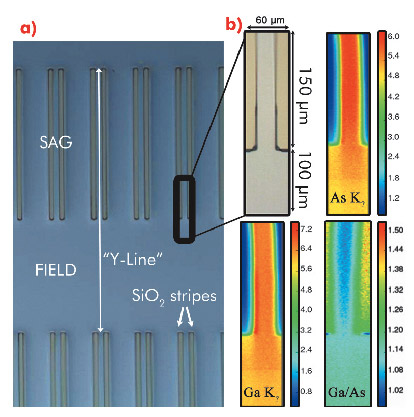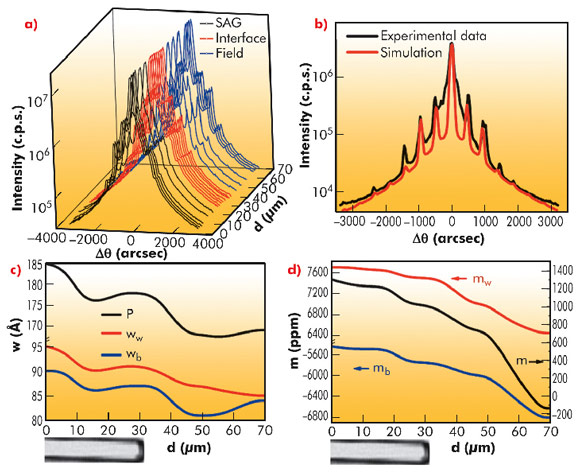- Home
- Users & Science
- Scientific Documentation
- ESRF Highlights
- ESRF Highlights 2010
- X-ray imaging
- Structure of multi-quantum wells in electroabsorption-modulated lasers for optoelectronics
Structure of multi-quantum wells in electroabsorption-modulated lasers for optoelectronics
Multi-quantum well (MQW) structures based on quaternary III-V semiconductor alloys are widely used in optical communication systems. Optoelectronic devices often require the integration of two different functions in the same chip. The selective area growth (SAG) technique gives excellent results for such monolithic integration [1]. SAG exploits the perturbation of the growth fluxes induced by a dielectric mask. When the metallorganic precursors collide with the dielectric mask, they are deflected and migrate through the unmasked semiconductor where the growth starts. In this way, the reactive species coming from the gas phase are enriched by those deflected by the mask and the result is a variation in composition and thickness of semiconductors grown near (SAG region) and far (field region) from the mask.
The electroabsorption modulated laser (EML), obtained by monolithic integration of an electroabsorption modulator (EAM) with a distributed feedback laser (DFB), is one of the most promising applications of SAG. A voltage modulation applied to the EAM switches it between an opaque and a transparent state by means of the Stark effect and ensures the modulation of the DFB laser emission, allowing long-distance communication (up to 80 km) at high frequency (10 Gb/s). The SAG EML device investigated here is an AlxwGaywIn1–xw–ywAs/AlxbGaybIn1–xb–ybAs (compressive-strained well/tensile-strained barrier) MQW structure grown on InP by metallorganic vapour phase epitaxy. The mask used for the growth (Figure 130a) featured 20 µm wide SiO2 stripes with a 30 µm opening width between them.
 |
|
Fig. 130: a) Optical micrograph of the SiO2 stripes-patterned InP substrate allowing SAG growth. The black rectangle, magnified in part (b), shows the region sampled in the XRF maps. b) Spatial maps of the fluorescence counts of the principal element’s lines. |
X-ray fluorescence (XRF) maps (Figure 130b) reveal that Ga Kα and As Kβ counts are higher in the SAG region owing to material enrichment caused by the SiO2 stripes. The effectiveness of the SAG technique in modulating the chemical composition of the quaternary alloy is proven by the map reporting the ratio between Ga and As counts in which a gradient in the average well/barrier chemical composition is clearly visible. Since the Ga/As ratio is lower in the SAG region than in the field, we can assert that the average Ga content of the MQW structure progressively increases by moving from the SAG to the field (along the Y-line showed in Figure 130a).
The structural parameters of the sample were investigated by m-X-ray diffraction (XRD): 35 different spatial points were sampled along the Y-line (Figure 131a). With such data, it is possible to obtain the widths (wb, ww, Figure 131c) and the mismatches (mb, mw, Figure 131d) of the barrier and of the well by fitting the observed patterns (Figure 131b) [2]. Both wb and ww undergo a modulated increase moving from field to SAG regions: this is the direct measure of the material enrichment in the SAG region. Moreover, both mb and mw values increase almost monotonically moving from the field to the SAG reflecting the expected modulation of the AlxGayIn1-x-yAs composition of barrier and well layers.
This key information, coupled with the µm-determination of the energy gap by photoluminescence, led to a characterisation of the structural gradient of the MQW structure along the Y-line from the field to the SAG region.
In summary, we determined the composition and the structure of the SAG EML device with a spatial resolution of 2 µm. This unprecedented characterisation allowed us to understand the structure and thus it gave the appropriate feedback needed to improve the growth process; such development was previously based only on a trial and error approach. A new generation of devices may be produced by extending this method to other SAG growths with different stripes and opening sizes [3,4].
Principal publication and authors
L. Mino (a), D. Gianolio (a), G. Agostini (a), A. Piovano (a), M. Truccato (b), A. Agostino (c), S. Cagliero (c), G. Martinez Criado (d), S. Codato (e) and C. Lamberti (a), Adv. Mater. 22, 2050-2054 (2010).
(a) Department of Inorganic, Materials and Physical Chemistry, University of Turin (Italy)
(b) Department of Experimental Physics, University of Turin (Italy)
(c) Department of General and Organic Chemistry, University of Turin (Italy)
(d) ESRF
(e) Avago Technologies Italy S.r.l., Turin (Italy)
References
[1] M.E. Coltrin and C.C. Mitchell, J. Crystal Growth 254, 35–45 (2003).
[2] C. Ferrari and C. Bocchi, in: Characterization of Semiconductor Heterostructures and Nanostructures; C. Lamberti, Ed.; Elsevier: Amsterdam, 93–132 (2008).
[3] L. Mino, A. Agostino, S. Codato and C. Lamberti, J. Anal. At. Spectrom. 25, 831-836 (2010).
[4] L. Mino, D. Gianolio, G. Agostini, A. Piovano, M. Truccato, A. Agostino, S. Cagliero, G. Martinez-Criado, F. d’Acapito, S. Codato and C. Lamberti, Small 7, in press, DOI: 10.1002/smll.201001229 (2011).




